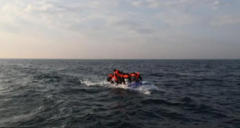Why Are So Many Unaccompanied Children Crossing the Channel in Small Boats?

Understanding the Surge of Unaccompanied Asylum-Seeking Children in Kent
In recent months, Kent County Council (KCC) has witnessed a dramatic surge in the number of unaccompanied asylum-seeking (UAS) children arriving in the UK via small boats. With a record high of 70 children arriving in a single day, the implications of this influx are profound and complex. This article explores the trends, challenges, and potential solutions surrounding the care of these vulnerable children in Kent.
The Current Landscape of Unaccompanied Asylum-Seeking Children in Kent
As of the first half of 2025, KCC has reported receiving 705 UAS children, a notable decline compared to 1,165 arrivals during the same period in 2024. However, the recent spike of new arrivals raises concerns about the capacity and resources of local authorities responsible for their care.
Recent Statistics and Trends
- 70 UAS children arrived in Kent on a single day, marking a record high.
- Another 48 children arrived the following day, indicating a potential ongoing trend.
- In total, nearly 20,000 people arrived in the UK via small boats in the first six months of 2025, reflecting a 48% increase compared to the same period in 2024.
- The number of small-boat arrivals in 2025 has been the highest since data collection began in 2018.
These statistics underline a significant and ongoing challenge faced by KCC and other local councils across England. The situation is further complicated by recent fluctuations in arrival numbers, attributed to factors such as adverse weather conditions and improved age assessment protocols at the borders.
Factors Influencing the Recent Surge
The sudden increase in UAS children arriving in Kent can be attributed to several interconnected factors:
Adverse Weather Conditions
Historically, adverse weather conditions have played a significant role in the patterns of asylum-seeking journeys. The first two months of 2025 saw severe weather, which initially reduced the number of crossings. However, as conditions improved, the flow of arrivals surged, leading to record numbers. This cyclical pattern highlights the influence of natural elements on human migration.
Improvements in Age Assessments
Another critical factor affecting the number of UAS children is the accuracy of age assessments conducted by Border Force teams. Enhanced protocols have allowed for a more reliable identification of unaccompanied minors, ensuring that they are appropriately referred to KCC for care. This increase in accuracy may have contributed to the recent spike, as more children are being correctly classified as UAS.
The Impact on Kent County Council
KCC is mandated to care for unaccompanied children arriving in Dover. The council faces several challenges, including a lack of resources and the pressing need for additional support from the government. The recent rise in arrivals has exacerbated an already strained system, leading to urgent calls for increased capacity and funding.
Challenges Faced by KCC
- Resource Strain: The sudden influx of children can overwhelm existing facilities and staff.
- Long-Term Planning: The council must balance immediate needs with long-term strategies for care and integration.
- Collaboration with Other Councils: Under the National Transfer Scheme, KCC works to distribute children across other local councils, but this can be challenging due to varying capacity levels.
Government Response and Future Considerations
The UK government has made efforts to address the growing numbers of asylum seekers. Over the past two years, funding has been allocated to KCC to establish five new reception centers aimed at improving care for UAS children. However, local authorities continue to call for more support and collaboration to build capacity across the county effectively.
Calls for Increased Support
In light of the increasing demand for services, the former Conservative leader of KCC has urged the government to commit to further support for local councils. The Association of Directors of Children’s Services has echoed this sentiment, emphasizing that unprecedented demand requires a coordinated response from central government.
The Changing Profile of Asylum-Seeking Children
Recent reports indicate a shift in the demographics of unaccompanied minors arriving in the UK. There has been an increase in the number of children from Eritrea, Somalia, and Sudan, while the numbers of Afghan and Kurdish children have decreased. This changing profile presents unique challenges and necessitates tailored support for these vulnerable groups.
Understanding the Needs of New Arrivals
With a diverse mix of nationalities, unaccompanied minors require comprehensive support that considers their cultural backgrounds, trauma experiences, and specific needs. The services provided must be adaptable to ensure that each child receives the appropriate care and assistance they require.
Future Implications and Considerations
The ongoing situation of unaccompanied asylum-seeking children in Kent raises important questions about the future of immigration policy, local capacity, and the welfare of vulnerable children. As discussions around small boat crossings continue, collaboration between local councils, the government, and support organizations will be critical in addressing the challenges ahead.
Potential Strategies Moving Forward
- Increasing funding for local councils to enhance capacity and services.
- Improving the efficiency of the National Transfer Scheme to ensure equitable distribution of children across the country.
- Enhancing training for staff working with unaccompanied minors to address their unique needs and backgrounds.
- Fostering community support and engagement to create a welcoming environment for new arrivals.
Conclusion
The record number of unaccompanied asylum-seeking children arriving in Kent presents both challenges and opportunities for local authorities. While the situation is complex, it highlights the need for a compassionate and coordinated response to support these vulnerable children. As discussions about immigration policy continue and the government seeks solutions, the welfare of these children must remain a priority.
As we consider the future of unaccompanied minors in the UK, it is vital to reflect on our collective responsibility to ensure their safety, well-being, and integration into society. How can we better support these children in their journey towards a hopeful future?
Frequently Asked Questions
What are the main reasons for the increase in unaccompanied asylum-seeking children in Kent?
The increase can be attributed to a combination of improved weather conditions, which facilitate crossings, and enhanced accuracy in age assessments conducted at the border.
How does Kent County Council care for unaccompanied minors?
KCC is responsible for the care of unaccompanied minors upon their arrival in Dover, providing them with necessary support, accommodation, and assistance in navigating the asylum process.
What challenges does KCC face in accommodating unaccompanied children?
KCC faces challenges such as resource strain, the need for long-term planning, and the complexities of collaborating with other local councils to distribute children effectively.
As the situation continues to evolve, the focus must remain on ensuring that unaccompanied asylum-seeking children receive the support and care they need to thrive. #UnaccompaniedMinors #AsylumSeekers #KentCountyCouncil
Published: 2025-07-04 10:41:26 | Category: technology



